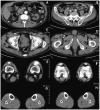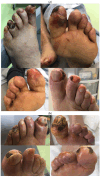Heparin-Mediated Extracorporeal Low-Density Lipoprotein Precipitation Apheresis for Treating Peripheral Arterial Disease in Patients with Chronic Kidney Disease
- PMID: 38398435
- PMCID: PMC10889472
- DOI: 10.3390/jcm13041121
Heparin-Mediated Extracorporeal Low-Density Lipoprotein Precipitation Apheresis for Treating Peripheral Arterial Disease in Patients with Chronic Kidney Disease
Abstract
Patients with chronic kidney disease (CKD), particularly those with end-stage renal disease (ESRD), have a high prevalence of cardiovascular disease and peripheral arterial disease (PAD). Medical treatment is mainly based on risk factor management, and the surgical approach remains the gold standard treatment in specific conditions. Heparin-mediated extracorporeal low-density lipoprotein precipitation (H.E.L.P.) apheresis is effective in reducing circulating lipoprotein, fibrinogen, inflammatory mediators and procoagulant factors, thereby reducing cardiovascular risk in patients with familial hypercholesterolemia and hypertriglyceridemia. These activities may be effective in reducing symptoms and ischemic vascular lesions even in patients with severe PAD. We reported the application of a treatment protocol with H.E.L.P. apheresis in an ESRD patient with severe PAD without clinical improvement after severe revascularization who was not suitable for further surgical approaches, despite normal LDL cholesterol and lipoprotein (a). The H.E.L.P. protocol was characterized by an intensive first phase with weekly treatments followed by a single session every 10-15 days for 6 months of treatment. The overall clinical condition, foot lesions and walking distance improved significantly after the first 2 months of treatment, and foot amputation was avoided. Here, we review the main pathogenetic mechanisms through which LDL apheresis improves microcirculation and clinical outcomes. Its wider application may represent an optimal therapeutic option for patients unresponsive to standard treatment.
Keywords: chronic kidney disease; heparin-mediated extracorporeal low-density lipoprotein precipitation; peripheral arterial disease.
Conflict of interest statement
L.G. received research funding from Abionyx and Sanofi, and received fees from Fresenius, Estor, Werfen, Astellas, AstraZeneca, Travere, Sandoz, Baxter, Mundipharma, Pharmadoc, Retrophin, GSK, Novartis and Chinook. M.F. received speaker fees from Estor and AstraZeneca. S.R. declares no competing interests.
Figures





Similar articles
-
Low-density lipoprotein apheresis: an evidence-based analysis.Ont Health Technol Assess Ser. 2007;7(5):1-101. Epub 2006 Nov 1. Ont Health Technol Assess Ser. 2007. PMID: 23074505 Free PMC article.
-
Effect of low-density lipoprotein apheresis on patients with peripheral arterial disease. Peripheral Arterial Disease LDL Apheresis Multicenter Study (P-LAS).Int Angiol. 2006 Sep;25(3):287-92. Int Angiol. 2006. PMID: 16878078 Clinical Trial.
-
Defining the role of lipoprotein apheresis in the management of familial hypercholesterolemia.Am J Cardiovasc Drugs. 2011 Dec 1;11(6):363-70. doi: 10.2165/11594970-000000000-00000. Am J Cardiovasc Drugs. 2011. PMID: 22149315 Review.
-
HELP-(Heparin-induced Extracorporeal LDL Precipitation)-apheresis in heart recipients with cardiac allograft vasculopathy and concomitant hypercholesterolemia: Influence of long-term treatment on the microcirculation.Clin Hemorheol Microcirc. 2019;73(1):19-27. doi: 10.3233/CH-199216. Clin Hemorheol Microcirc. 2019. PMID: 31561344
-
Low-density lipoprotein apheresis: an overview.Ther Apher Dial. 2003 Aug;7(4):382-90. doi: 10.1046/j.1526-0968.2003.00070.x. Ther Apher Dial. 2003. PMID: 12887719 Review.
Cited by
-
Lipid Toxicity in the Cardiovascular-Kidney-Metabolic Syndrome (CKMS).Biomedicines. 2024 Apr 29;12(5):978. doi: 10.3390/biomedicines12050978. Biomedicines. 2024. PMID: 38790940 Free PMC article. Review.
References
-
- Hirsch A.T., Criqui M.H., Treat-Jacobson D., Regensteiner J.G., Creager M.A., Olin J.W., Krook S.H., Hunninghake D.B., Comerota A.J., Walsh M.E., et al. Peripheral arterial disease detection, awareness, and treatment in primary care. JAMA. 2001;286:1317–1324. doi: 10.1001/jama.286.11.1317. - DOI - PubMed
Publication types
LinkOut - more resources
Full Text Sources

